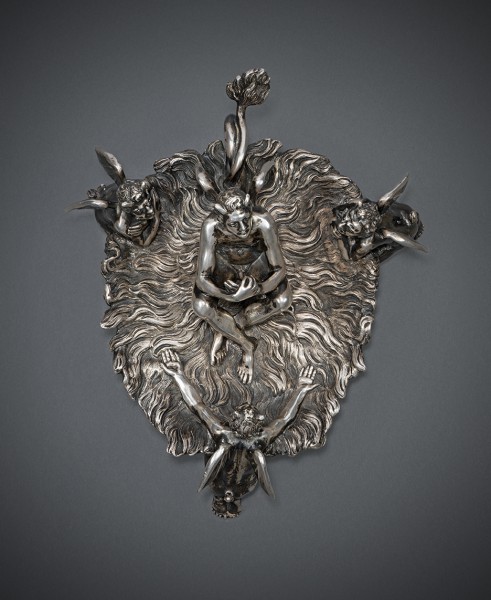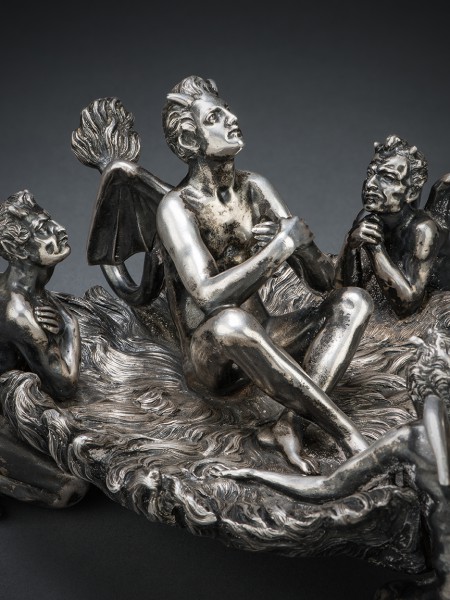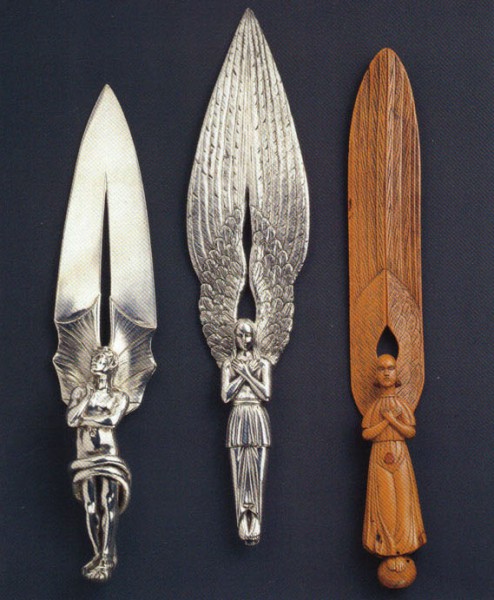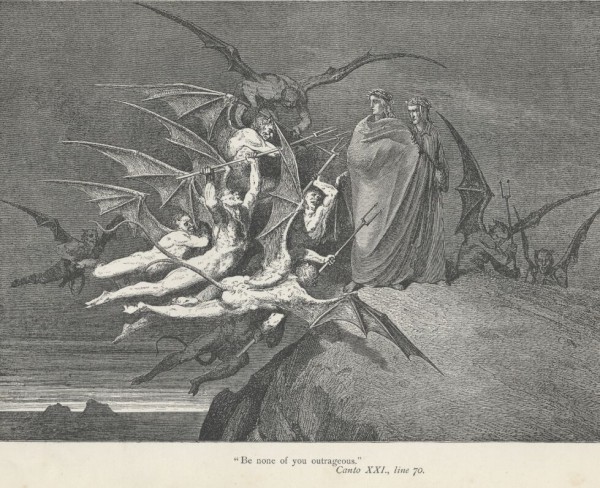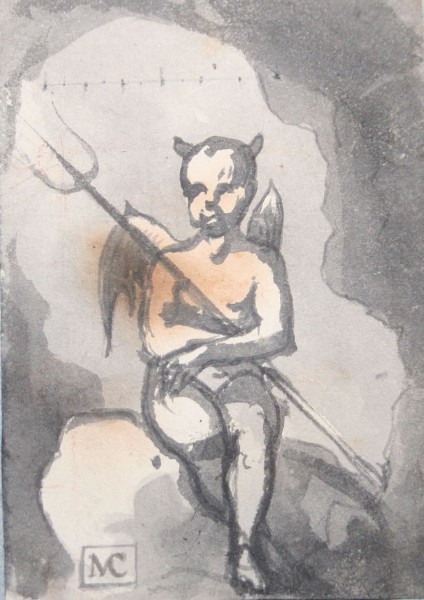The Inferno Silver Chamber Candlestick by Castellani, Rome, circa 1865
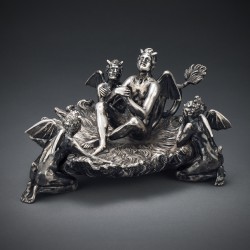
Designed as three demons kneeling round a bed of flames on which another demon sits, its arms curved to support a candle and its tail looped as a handle. The three smaller demons serve as the feet of the chamber candlestick and seem to pay homage, each in its own way, to the seated devil in the centre. Signed and dated: Augusto Castellani, Roma 1865-1881
Date: Rome, c 1865
Material: Oxidized Silver
Artist: Augusto Castellani
Conceived by: Michelangelo Caetani, Prince of Teano, Duke of Sermoneta (1804-1882).
Cast by: Antonio Messina
Dimensions: 205mm / 8”.
Weight: 1181 grams (38 troy ounces).
I discovered this remarkable and important silver chamber candlestick in a UK regional auction. After a year of research in London and Rome, I identified it as an important surviving artwork by the Castellani workshop in Rome, the leading jewellers and goldsmiths of the 19th century. Conceived in tribute to Dante’s Inferno poem, the chamber candlestick is a cleverly conceived and meaningful object, full of allusion and hidden political meaning.
The chamber candlestick is the only known example from a range of devil candlesticks produced by the Castellani to designs of their principal patron, Michelangelo Caetani, Prince of Teano, Duke of Sermoneta. Raffaele Cesare (1845-1918) described Caetani as ‘an artist, with all the whims and eccentricities of the artist and the Roman prince’. As a scholar of The Divine Comedy, leading member of the Dantofili and high-profile figure in the Risorgimiento, Caetani designed a number of jewels and artworks for the Castellani in tribute to the poet Dante, weaving political comment into their creations. Augusto Castellani, Caetani’s closest collaborator at the firm, claimed that ‛almost every object made [after 1848 and the revolutions in Europe, was a] symbol of patriotic thoughts and emotions.’
Silver, wooden and ivory paperknives designed by Caetani using the same demon present on the chamber candlestick, as well as similar knives shaped as angels, were popular items with visitors to the Castellani’s Roman shop. Actress Fanny Kemble, who knew Caetani, called them ‛the most poetical of paper knives’ . The demon figure―of beautiful human form but with bat-like wings and tail―was drawn by Caetani directly from The Divine Comedy. Cesare suggested the demon figure was based on Minos with his ‛tail and wings twisted up’ who appears in the first circle of Dante’s Inferno as judge of the underworld. More likely, Caetani was inspired by the Malebolge, the eighth circle of Hell where Malacoda, or ‛evil tail’, rules the Malebranche. The Malebranche are mischievous winged demons with tails and horns who torment corrupt fraudsters and politicians, forcing them into a boiling tar. In the poem, Malacoda is not portrayed as an unduly malign figure for he protects the poet and his companion Virgil from harm, guiding them, under querulous escort of the Malebranche, out of the Malebolge. A metaphorical association to the use of a chamber stick is apparent, alongside barbed comment on the politicians who, in Caetani’s view, were dragging Italy to disaster. As a politician, Cesare may have been purblind to the allusion.
The chamberstick is at the heart of a flowering of interest and re-discovery of Dante by artists across nineteenth century Europe: from paintings by the Pre-Raphaelite brotherhood in England to La Porte de l’Enfer, a monumental bronze group by Auguste Rodin. It is dated 1865, the sixth centenary of the poet’s birth, when Dante was enthusiastically celebrated especially in Italy where he was a compelling emblem of the Risorgimento. Stefanie Walker, co-author of Castellani and Italian Archaeological Jewelry (Yale, 2004), has speculated that the second inscribed date of 1881 may be tied to the death of Caetani.
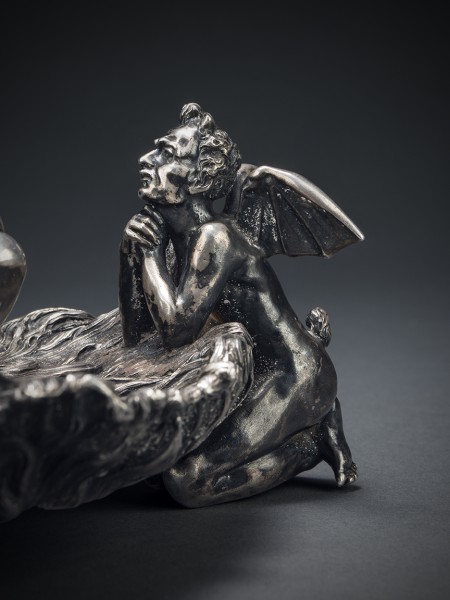
The original design for the chamber stick has not been found but from 1843 a number of candlesticks designed as demons and devils are noted in Castellani’s stock ledgers, alongside the paper knives. They are variously recorded as candeliere, porta candele, bugia, or bugiola: ways which describe a single candle holder or chamber stick. They are sometimes further distinguished as grande or piccolo. The first example, described as Bugia di argento Lucifero , was completed in July 1843 by a silver worker called Bosatti. However, Caetani was unimpressed. ‛In the past year’ he wrote his close friend, English diplomat Edward Cheney that November, ‛I made a small Lucifer in bronze that Castellani then transferred into silver. Many liked the idea and it had greater success than the angel, but the execution was so “dull”… among many fine virtues, Castellani has the fault of using skilled craftsmen at any price, which cannot be in his best interest’ . Henceforth work the chamber sticks would be entrusted to the more highly regarded Antonio Messina. A comment by Caetani’s widow suggests that the bronze figure on which the principal demon is based may originally have been a gift to her husband by the Grand Duke of Saxe-Weimar in return for an ivory angel paper knive. The principal demon is certainly highly suggestive of a Renaissance bronze of a youth.
It is likely that the principal demon was used as the original and subsequent piccolo versions of the devil chamber sticks. The addition of three further smaller demons to support this figure on a bed of flames may have been at Caetani’s direction to create the grande range of devil chamber candlesticks. This may explain why―when no designs for the principal figure survive―drawings closely relating to the smaller kneeling figures are found in Caetani’s albums.
In addition to their size, over the years of production the chamber sticks were given differing descriptions of form. Distinction is made in the ledgers between the simple, single figure Bugia Lucifero and the more complex, multi-figure Bugia Congresso Diavoli ; Bugiola rito diabolico; Candelliero grande rito Lucifero and Portacandele Lucifero tregenda, all of which describe a ‛meeting’ of devils (see appendix). Moreover, an entry in the 1846 stock ledger specifically attributes a devil chamber candlestick to the ‛Prince of Teano’. It has not been possible to identify the precise number of candlesticks produced as repeated entries, by various workshop staff using idiosyncratic terms, may refer to the same object held in stock over succeeding years. The survival of only the present example suggests that far fewer were made than the ledgers indicate. Only two buyers are known: a Russian Count Ousouleff and the King of Italy, Umberto I, who purchased a Candeliere Diavolo from Augusto Castellani on 3rd December 1887 for 700 lire.
Research report of Amanda Triossi F.G.A., Jewellery historian, author and Curator of the Bulgari Collection
The Devil Silver Chamber Candlestick by Augusto Castellani, probably after designs by Michelangelo Caetani, Prince of Teano, Duke of Sermoneta, Rome, circa 1865, Inscribed and dated: “Augusto Castellani, Roma 1865-1881”.
Weight of the chamber candlestick is 1181 grams (38 troy ounces). Length approx. 205mm.
The silver chamber candlestick represents three devils kneeling round a bed of flames on which another devil sits, its arms curved so as to support the candle. The three devils serve as the feet of the chamber candlestick and seem to pay homage, each in its own way, to the seated devil in the centre.
The authenticity of the object, which is of very high level of workmanship, is not in question.
It was certainly executed for the Castellani by Antonio Messina, a silversmith of excellent reputation1, who collaborated with the Castellani family for a long time. Research however has not produced any date more precise than the one engraved on the base of the object.
Documents consulted:
Fondo Famiglia Castellani, Archivio Storico di Roma (ASR)
– Stock ledgers
– Workers ledgers
– Silver ledgers
Fondo Michelangelo Caetani, Archivio Camillo Caetani, Roma.
– Designs
– Various correspondence received by Michelangelo Caetani.
Conclusions:
1) Given that the manufacture of silver objects was a marginal activity of the Castellani, it was not documented with the same detail and accuracy in their accounts as their “neo- archaeological” jewellery manufacture for which they were especially renowned.
2) Numerous devil candleholders appear in the stock ledgers between 18432 and 1899. Because of unavailable documentation, it is difficult to distinguish the objects remaining in stock for a number of consecutive years from newly created ones.
3) The authorship of the design is to be attributed to Michelangelo Caetani:
a) we know that he designed the 1843 a devil candleholder, and that it was highly appreciated in spite of its poor workmanship 3.
b) listed in the 18464 ledger are “4 Devil candleholders (Pe. Di Teano)”;5
c) Caetani’s passion and study of Dante and his intimate knowledge of the Inferno may have prompted the devil subject matter, however the object with its unthreatening rendering of the devils follows a typically nineteenth-century devil iconography;
d) several devil paper knives of Castellani exist with relative designs by Caetani;
e) the talent of Caetani, his social position, and the long relationship of reciprocal friendship between the two families makes it difficult to believe that there was a need on he part of the Castellani to seek a different source.
4) The descriptions of the objects in the ledgers are inevitably brief given their very nature: the typology is described with different Italian nouns (candeliere, portacandele, bugia, bugiola). These seem to be used arbitrarily but what they all have in common is that they
describe a candleholder for a single candle (for the sake of simplicity these various Italian nouns have been translated consistently in English as “candleholder”). The dimensions in the legers are indicated with only two adjectives, big and small; the subject with Devil or Lucifer.
5) One type of devil candleholder is described with the word “rite” (diabolic rite, Lucifer rite, rite of the devil, etc.). This appears in the ledgers between 1852 and 1855 and then, in irregular fashion, from 1870 to 1899. Even these entries make it difficult to establish the exact number produced as well as to know whether they were all based on the same design.
6) To date, no other similar devil chamber candlesticks or designs have been found.
With regard to the dating of the object, it is useful to point out some coincidences that have been observed.
Listed in the stock ledger of 18556 (the date of 15 June refers to the heading of the general ledger) is the interesting definition “Portacandele Lucifero tregenda” while the Workers Ledger 7 of the following year – an account in fair copy in the middle of the volume – lists twenty works already executed by Messina (unfortunately without a date) among which a “Bugia, Congresso Diavoli” (“Candleholder, Devils’ Congress”). In fact tregenda, in Italian, means a reunion (or congress) of devils or witches: Walpurgis Night. That which has been just reported is, however, the only description that we have regarding the meaning of the word “rite” which is frequently cited in the stock ledgers. We cannot know if this has to do with one single piece or to one of many that were executed from a single design. If we accept the first hypothesis, we could anticipate the date of the Portacandele Lucifero tregenda (“Candleholder Lucifer Walpurgis Night”) of 1855 to 1852 where a “Bugiola rito diabolico” (“Diabolic Rite Candleholder”) is first encountered in the ledger8 and where the cost price and the sales price are indicated. Such figures remain identical during the years 1853-18589 for a single exemplar10 described from time to time as follows:
Bugia rito Lucifero (1853)11, Porta candele lucifero.rito.argento (1854)12, Portacandele Lucifero tregenda (1855), Bugia Diavolo grande (1857)13, Portacandele Lucifero (1858), Portacandele grandi lucifero (1859)14. In later years the word “rite” reappears in descriptions starting from 1870. Since the only documents existing between 1852 and 1855 are the stock ledgers, this leads us to presume that it might be the same object that remained unsold, while in 1856 we know from the Workers Ledger that several devil candleholders were executed. Some confirmation regarding the manufacture of devil candleholders is to be found in the Workers Ledgers15 and in a one and only ledger entitled “Registro degli Argenti” (Silver Ledger)16.
The table in the appendix clearly illustrates the available dates cited in the different Castellani account books and it is obviously difficult to establish a certain correspondence between the objects present in the stock ledgers and those included in the production documentation. It should be kept in mind that ledgers were generally closed in the month of June, while the Workers Ledgers refer to the dates the silver was consigned. Furthermore, apart from the case mentioned (1856 register), the word ‘rite’ never appears in the descriptions, only the adjectives big and small.
The following attracts attention: In 1856, confirmation of the manufacture of the already-mentioned “Bugia Congresso diavoli”17.
a) In 1869, between January and March, different quantities of silver were consigned for a Bucia diavoli; however, the last entry refers to a Bucia Diavolone (Big Devil)18. The hypothesis that the sizes of the devil are being referred to here and not that of the candleholder is very tempting for the dating of our chamber candlestick. Unfortunately, the stock ledger of June 1869 makes no mention of a devil candleholder, and in the following year (June 1870)19 there is only a “Candeliere rito Diabolico”, but this probably refers to the object defined as Bucia diavoli grande that was executed between January and March of that same year.
b) On 3 December 1887, the King of Italy, Umberto I, purchased a devil candleholder20.
c) Between 1896 and 1899 21 it seems there remained unsold: a rite candleholder and two small devil candleholders, the latter executed in 1895.
References:
1 Antonio Messina was conferred with the title of Cav. of San Silvestro in1870 at the Esposizione Romana delle opere di ogni arte relative al Culto Cattolico, (M.Donati: Augusto Castellani autore della copia della Venere Ostiense già del Museo Lateranense, in Xenia 12 anno 1986, pp. 105-109). Messina, who had a laboratory in via Felice not far from the Castellani, was listed as Metallaro in the ledgers, which has a disparaging ring to it today but which must have been commonly accepted at that time. Messina was the artisan to whom the Castellani entrusted works of a certain calibre. Other silversmiths were instead charged with the execution or repair of silverware and still others with the execution of small elements in silver to insert in the jewellery. Starting in 1884, the name of Parisi replaces that of Messina.
2 The Silver Lucifer Candleholder, present in the ledger of 1843 (ASR, FFC, Reg. no. 83, Record no. 2258), executed in July by a certain Bosatti, (ASR, FFC, Reg. no. 127, Voce Argenti) was probably designed by M. Caetani who comments about its poor workmanship in a letter of November of the same year to his friend Edward Cheney (see note 3)
3 Letter to Cheney, November 1843: […] Nell’anno passato, per distrarmi dalle mie idee fisse, mi diedi a farne alcuni; e tra gli altri feci un piccolo Lucifero in bronzo, che poi Castellani ha trasferito in argento. L’idea piacque amolti, e fu piu fortunate dell’angelo, ma l’esecuzione fu cossi dull, che pochi vi sono che non se ne siano avveduti.[…]. (In the past year, as a distraction from my idée fixe, I started to make some; and among others I made a small Lucifer in bronze that Castellani then transferred into silver. Many liked the idea and it had greater success than the angel, but the execution was so “dull” that only a handful of people did not notice this.)
4 ASR, FFC, Reg. no. 84, Record no. 2222.
5 Where “4 “ is a clear indication of the number of chamber candlesticks and not of the devils as previously understood.
6 ASR, FFC, Reg. no.88, Record no. 798.
7 ASR, FFC, Reg. no.128, P.258.
8 ASR, FFC, Reg. no. 85, Record no. 1945, 1947.
9 A similar case is to be found in the stock ledgers from1876 to 1880 (lire 350) and from 1890 to 1899 (lire 300)
10 In the ledgers from 1853-1857 other Lucifer, but not “rite” candleholders are noted as well as devil paper knives.
11 ASR, FFC, Reg. no. 87, Record no. 746.
12 ASR, FFC, Reg. no. 88, Record no. 733.
13 ASR, FFC, Reg. no. 89, Record no. 863.
14 ASR, FFC, Reg. no. 92, Record no. 773.
15 Consulted: ASR, FFC, Reg. nos. 127-135 and Reg. no.140 (years 1883-1903),
16 ASR, FFC, Reg. no.158 (referring to the years 1858-1872).
17 This date, however, contrasts with the one engraved on the base of the object.
18 ASR, FFC, Reg. no.158. Year 1869-1870.
19 ASR, FFC, Reg. no. 92 (1859-1882), Record no. 64 (year 1870), no. 59 (1871)
20 ASR, FFC, Reg. no. 57, date 3 December 1887. The king also bought from the Castellani a silver centrepiece reproducing the Fountain of the Tortoises (Taddeo Landini 1588, Rome) the work of Parisi.
21 ASR, FFC, Reg. no. 98.
Rome 7th January 2014
Amanda Triossi
Download article in full as PDF. The Inferno Silver Chamber Candlestick
